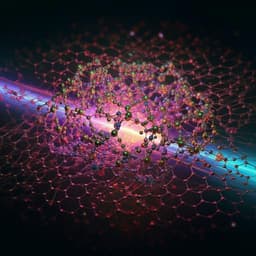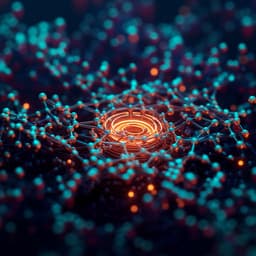
Engineering and Technology
Three-dimensional printing of silica glass with sub-micrometer resolution
P. Huang, M. Laakso, et al.
Discover groundbreaking research by Po-Han Huang and colleagues on 3D printing solid silica glass with sub-micrometer resolution without sintering. Utilizing sub-picosecond laser pulses for crosslinking, this technique not only produces optically transparent glass but also innovative applications in photonics, medicine, and quantum optics.
~3 min • Beginner • English
Introduction
The study addresses the challenge of fabricating three-dimensional silica glass structures with micrometer and sub-micrometer features. Conventional additive manufacturing methods for silica rely on sol-gel composites with high organic content and require high-temperature sintering (~1200 °C) to form glass, which causes large shrinkage, degrades pattern fidelity, and precludes integration on temperature-sensitive substrates. The authors aim to demonstrate a 3D printing process that directly forms solid, transparent silica glass with sub-micrometer resolution without a sintering step, enabling integration on diverse substrates and expanding applications in photonics, nano/micro-systems, and fluidics.
Literature Review
Prior approaches to 3D silica glass include stereolithography, direct ink writing, digital light processing, and multiphoton polymerization, as well as hybrid methods combining techniques and precursors. These methods typically achieve feature sizes of several tens of micrometers, with rare demonstrations of sub-micrometer resolution, and universally require sintering at ~1200 °C to remove organics and densify composites into glass, causing 16–56% shrinkage and limiting substrate compatibility. Hydrogen silsesquioxane (HSQ) has been used as a high-resolution negative-tone resist patterned via linear absorption using electron beams, ion beams, and deep UV for 2D or suspended planar structures, but free-form 3D fabrication was not feasible. Nonlinear (multiphoton) cross-linking of HSQ with sub-picosecond lasers had been explored, but results were limited to suspended 2D beams and lacked evidence of forming silica-glass networks.
Methodology
The 3D printing process comprises: (1) Drop-casting HSQ (FOX-16; solvents: methyl isobutyl ketone and toluene) onto cleaned glass substrates (fused silica JGS2, 250 µm thick, or borosilicate cover slips, 170 µm), building ~100 µm thick HSQ layers by repeated casting and overnight drying. (2) Direct laser writing in dried HSQ using a sub-picosecond laser (1040 nm, 10 kHz, 298 fs; Spirit 1040-4-SHG) focused through the substrate into HSQ. Motion by 3-axis motorized stage at 0.5–1 µm/s. Objectives: 40× NA 0.65 (air) for larger features and 63× NA 1.4 (oil immersion) for sub-micrometer features. Typical single-pulse energies: 14–18 nJ (NA 0.65) and ~7.5 nJ (NA 1.4), measured post-objective. (3) Development: unexposed HSQ removed by immersing in 0.1 M KOH (aq) with 0.05 vol% Triton X-100 for at least 8 h, rinse DI water, air-dry (critical-point drying used for delicate samples). Optional annealing performed in air: heat from room temperature to target (150–1200 °C), hold 1 h, passive cool; samples removed below 150 °C. Characterization: - Electron microscopy: SEM and STEM on FIB-prepared cross-sections; TEM and electron diffraction to confirm amorphous SiO2; EDS at 11 points for composition. - Raman spectroscopy and photoluminescence: confocal Raman (405 nm excitation; 600 g/mm grating; <5 mW; 100×, NA 0.9) on suspended blocks 7–9 µm above substrate; spectra collected for as-printed and annealed samples (150–900 °C). - Shrinkage measurement: five T-shaped test structures measured by SEM before/after anneals; calibrated using fixed pillar spacing; error propagation included. - Nanoindentation: Hysitron TI 950 with Berkovich tip; Oliver–Pharr method; samples: (i) 3D-printed microplates (20×20 µm, ~2 µm thick) on fused silica, (ii) flat fused silica substrate, (iii) laser-engraved fused-silica microplates; both as-printed and annealed at 900 °C; indent depth ≤200 nm. Photonic device demonstration: Design and fabrication of a 3D-printed microtoroid resonator with integrated bus waveguide. Waveguide cross-section ellipsoidal (~2.5 µm high, 1.2 µm wide). Toroid radius 15 µm to achieve FSR ~16 nm near 1550 nm. Directional coupler gap 500 nm, length 23 µm; ends of bus waveguide orthogonal for stray light suppression. Optical characterization: transmission in 1460–1580 nm using a tunable laser (1 mW) and analyzer; coupling with tapered single-mode fibers; polarization control; spectra acquired for multiple input positions; measurements repeated after anneals at 150 °C, 300 °C, and 900 °C. Spectral modeling: all-pass single-mode ring model fitted via genetic algorithm to extract effective index, group index, FSR, and loaded Q across conditions.
Key Findings
- Direct 3D printing of solid, optically transparent silica glass from pure HSQ via nonlinear absorption of 1040 nm sub-picosecond laser pulses, without sintering, achieving sub-micrometer resolution. - Smallest voxel dimensions: ~65 nm (width) × 260 nm (height), aspect ratio ~4. - Material composition and structure: TEM electron diffraction confirms amorphous silica; EDS indicates Si and O with residual carbon <1 at.% in as-printed material; no porosity observed down to a few nm. - Raman spectroscopy: as-printed glass exhibits features of silica glass with additional signals from Si–H, OH/water, carbon species, and increased 3- and 4-membered ring features; photoluminescence background centered slightly above 2 eV attributed to laser-induced defects (NBOHCs, Si clusters, oxygen-deficiency centers). - Thermal treatments: Si–H eliminated at 150 °C; OH/water and carbon species removed by 900 °C anneal; photoluminescence removed by 900 °C; Raman spectrum after 900 °C indistinguishable from fused silica. - Shrinkage: ultimate linear shrinkage upon 900 °C anneal is (6.1 ± 0.8)%; no cracking or delamination observed; annealing at 1200 °C induces reflow and smoothening without structural failure. - Mechanical properties (nanoindentation on ~2 µm plates): as-printed hardness 2.4 ± 0.2 GPa and reduced modulus 40 ± 2 GPa; after 900 °C, hardness 7.7 ± 0.6 GPa and modulus 75 ± 2 GPa, matching fused-silica references. - Optical transparency validated by imaging through 3 µm-thick suspended plates; surface smoothness improved via 1200 °C anneals. - Photonic device: 3D-printed microtoroid resonator with integrated bus waveguide exhibits clear resonances in S/C/L bands; FSR measured aligns with predicted ~16 nm at 1550 nm; functionality maintained before and after anneals up to 900 °C. - Integration capability: successfully printed a suspended silica glass plate on the tip of an optical fiber without damaging temperature-sensitive polymer coatings, demonstrating compatibility with temperature-sensitive substrates.
Discussion
The findings demonstrate that nonlinear laser cross-linking of HSQ enables additive manufacturing of solid, transparent silica glass microstructures with sub-micrometer features, eliminating the need for high-temperature sintering required by sol-gel-based methods. This addresses the key limitations of prior techniques by drastically reducing post-process thermal budgets, minimizing shrinkage (~6%), and allowing direct integration on diverse or temperature-sensitive substrates (e.g., polymer-coated fibers). The as-printed glass exhibits minor deviations from fused silica (enhanced 4-membered ring content and photoluminescence), which are fully mitigated by a modest 900 °C anneal that also brings mechanical properties to parity with fused silica. The successful fabrication and operation of a microtoroid resonator and other micro-optical elements confirm that the optical quality of the printed glass suffices for photonic applications even prior to anneal, and that post-annealing yields properties indistinguishable from fused silica. Compared to linear-absorption HSQ lithographies and subtractive laser-defined etching, this method uniquely provides true free-form 3D glass structuring on surfaces with high resolution and integration flexibility, expanding opportunities in photonics, nanofluidics, NEMS/MEMS, and quantum technologies.
Conclusion
This work introduces a 3D printing technology that directly forms transparent, solid silica glass from HSQ with sub-micrometer resolution via nonlinear absorption of sub-picosecond laser pulses, obviating sintering. The process produces dense, amorphous SiO2 with low shrinkage and high fidelity; optional 900 °C annealing removes residual species and photoluminescence and yields mechanical and spectroscopic properties equivalent to fused silica. Demonstrations include micro-optical components such as a microtoroid resonator and integration on temperature-sensitive substrates like optical fiber tips. Future research directions include elucidating the mechanisms of multiphoton HSQ cross-linking, strategies to reduce the formation of 4-membered rings and eliminate photoluminescence in as-printed glass, and extending functionality by incorporating or coating additional materials (e.g., nanodiamonds for quantum photonics, ferrous nanoparticles for magnetic actuation).
Limitations
As-printed glass exhibits a higher ratio of 4-membered Si–O rings and photoluminescence, along with residual Si–H, OH/water, and trace carbon species; while optional, a 900 °C anneal is needed to fully match fused-silica properties. A residual linear shrinkage of ~6.1% occurs upon 900 °C anneal due to amorphous network rearrangement and minor crystallization. Optical fiber-to-waveguide coupling in device tests experienced mode mismatch and sensitivity to alignment due to multimode waveguides. The development step is relatively long (≥8 h in KOH with surfactant), and highest resolution requires high-NA oil immersion optics and precise laser control.
Related Publications
Explore these studies to deepen your understanding of the subject.







